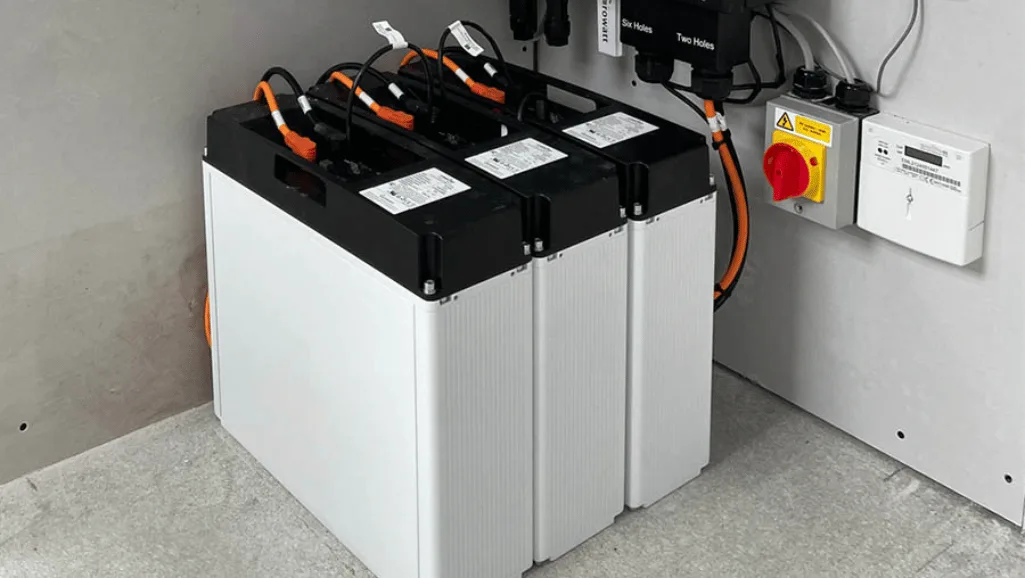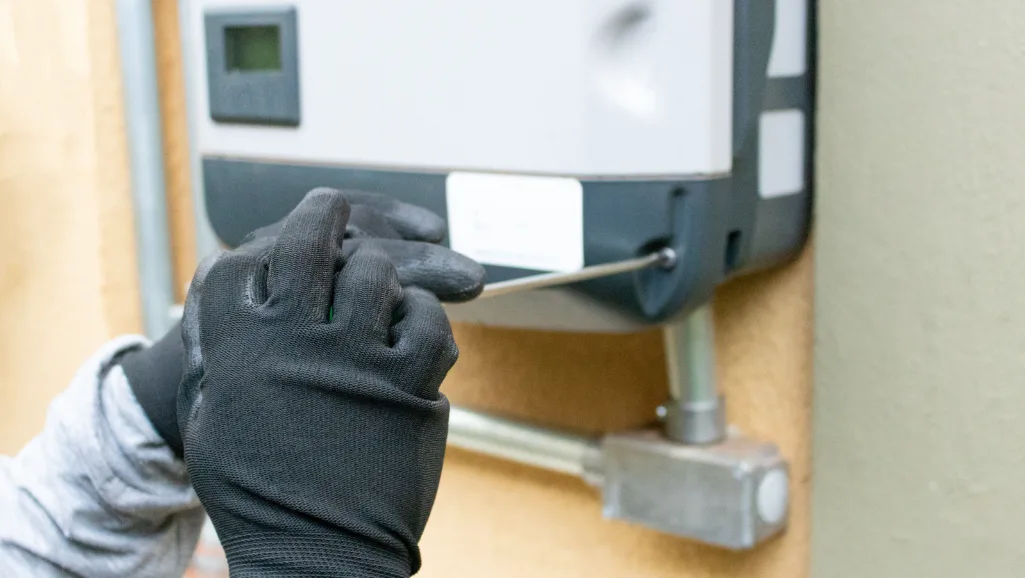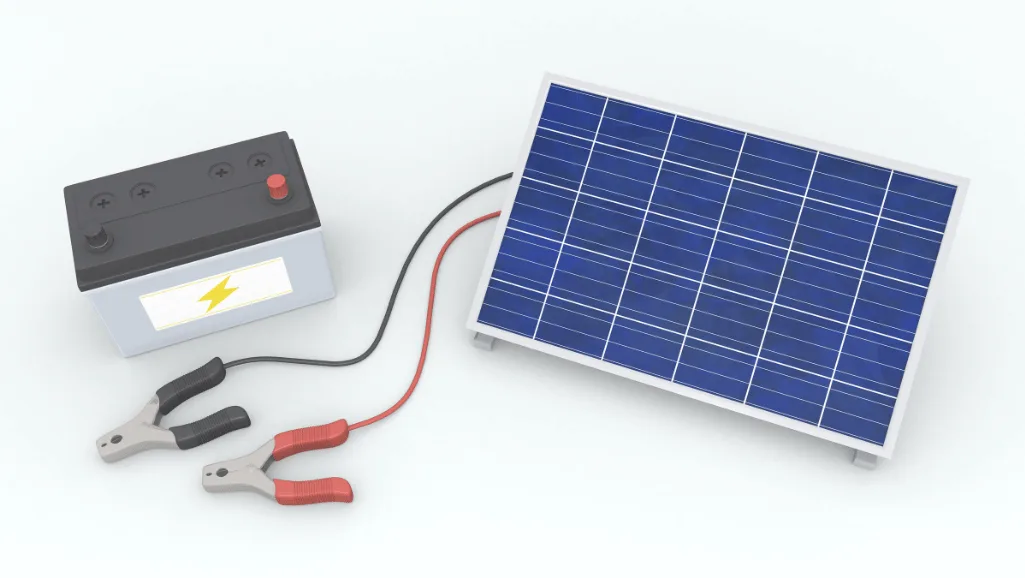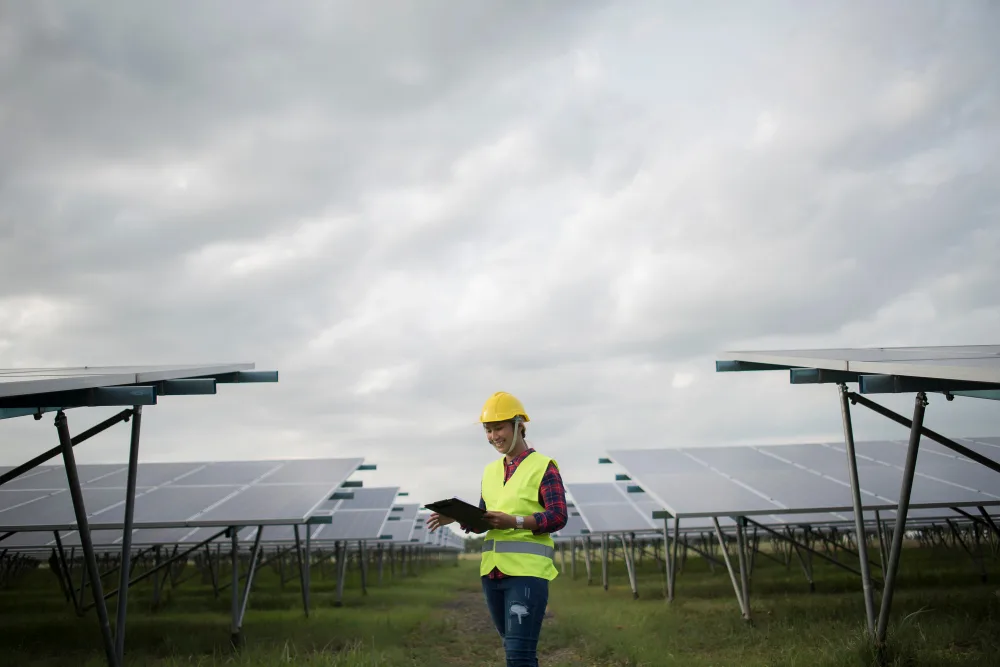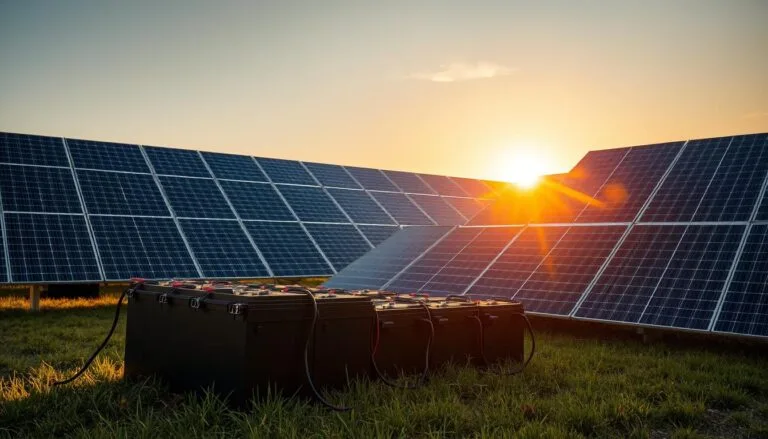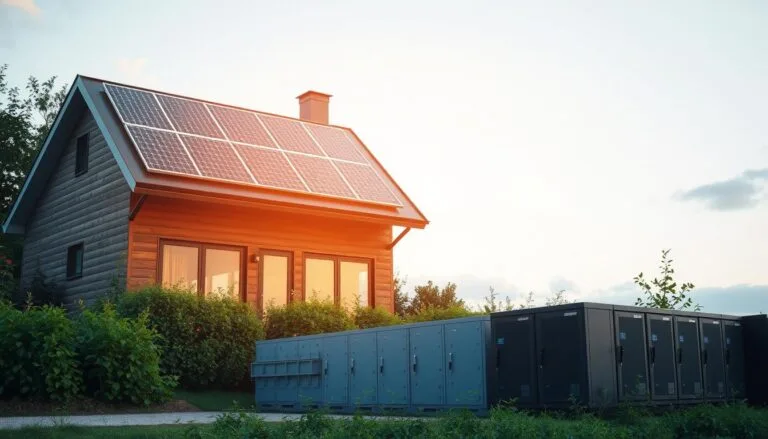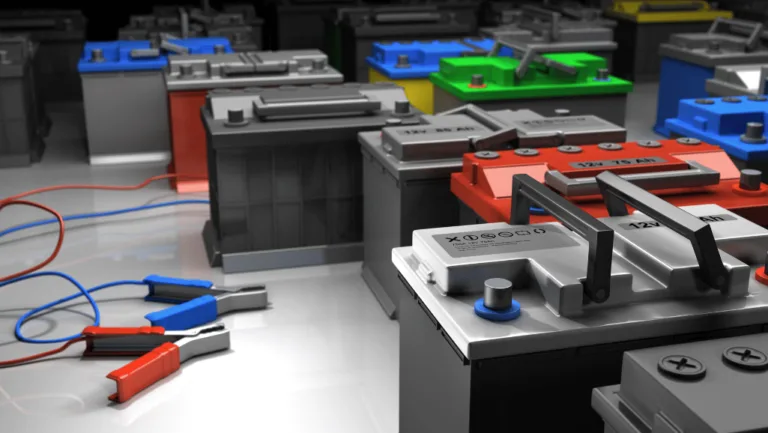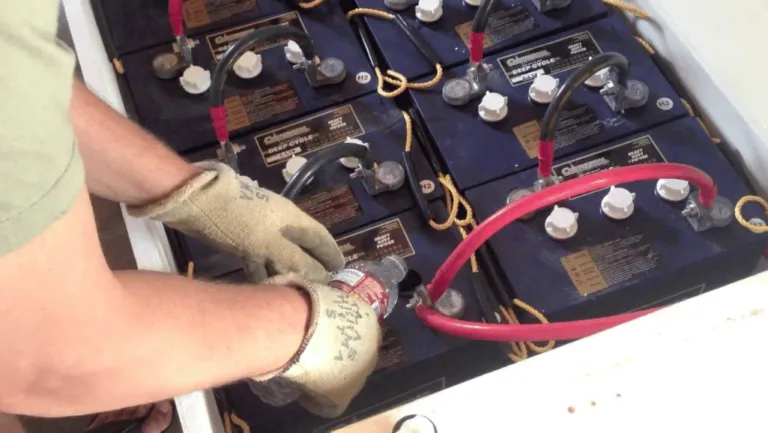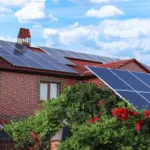Solar batteries are key to any solar system, letting you save energy for later. Keeping them in good shape is vital for your system’s long life and efficiency. Regular care for deep-cycle batteries keeps your solar power system working well, saving you money over time.
Knowing how to maintain solar batteries is the first step to a smooth system. Things like high temperatures, moisture, and wrong charging can lower battery efficiency and shorten its life. By following a regular maintenance plan and keeping up with solar battery tech, you can keep your solar power system running well for many years.
Key Takeaways
- Regular solar battery maintenance is crucial for optimal system performance
- Proper charging and balanced usage can extend battery lifespan
- Extreme temperatures and moisture can negatively impact battery efficiency
- Periodic professional check-ups are recommended for assessing battery health
- Staying updated with solar battery technology can improve system efficiency
The Importance of Solar Battery Maintenance
Solar batteries are key to storing extra energy from solar panels. They keep the power going even when the sun isn’t shining. Keeping these batteries in good shape is crucial for their performance and life. Lead-acid and lithium-ion batteries need different care, so it’s important to know what they require.
About 80% of solar battery failures are due to sulfation. This happens when sulfur crystals block the chemical reactions in the battery. It’s often caused by not fully charging the battery or low electrolyte levels. To avoid this, check the battery’s charge often and make sure it goes through the right charging stages.
Checking the specific gravity of the battery is also key. This tells you the battery’s charge level. Keeping the specific gravity right is vital for the battery to work well. The battery’s life also depends on storage temperature and how deeply it’s discharged, so these should be considered during maintenance.
| Battery Type | Lifespan | Cost (Residential System) |
|---|---|---|
| Lead-acid | 1-10 years | $200-$800+ |
| Lithium-ion | 7-15 years | $7,000-$14,000 |
Regularly cleaning battery terminals with baking soda and water helps keep them working well. When you replace old batteries, don’t mix them with new ones. This can lower the quality of the newer batteries, showing why good maintenance is important.
When taking care of solar batteries, always wear protective gear and have safety items ready. Batteries can release flammable gases and acid, so it’s key to follow safety rules. This helps prevent accidents and keeps the solar system running well.
Knowing how to maintain solar batteries is key to keeping them working right. This includes checking their charge, cleaning terminals, and being safe. With regular care and the right tools, solar power systems can work better and last longer.
Regular Inspection and Cleaning
To keep your solar battery system working well, you need to check and clean it often. Solar panels can last more than 25 years with the right care. This means they can keep giving you power for your off-grid power systems. Check your system at least twice a year to catch any problems early.
When you inspect your system, look for any damage or wear that could slow it down. Even a little dust on the panels can cut down on energy production and savings. For example, dust on 20 panels can mean losing $30 in savings, which could add up to a lot over time.
Checking for Damage and Wear
Check the batteries, inverter, and other parts of your solar battery system for damage or wear. Watch for cracks, leaks, or corrosion. Use a solar monitoring system to keep an eye on how well your system is working. This can spot any drops in efficiency that need fixing.
How much it costs to clean and maintain solar panels can change based on several things. This includes repairs needed, the type of inverter, and the area around the panels. Ground-mount systems are usually cheaper to keep up than rooftop ones. Still, cleaning them regularly helps keep them working at their best.
Keeping Battery Terminals Clean
Keeping the battery terminals clean is also key to battery bank maintenance. A clean connection means better performance and longer battery life. For lead-acid batteries, stopping corrosion early is crucial. Make sure to check the terminals often and keep them tight to avoid rust.
| Maintenance Task | Frequency |
|---|---|
| Thorough O&M inspections | Twice a year |
| Solar panel cleaning | As needed (more frequently in dusty environments) |
| Battery terminal cleaning | Monthly |
| Equalization charging | Every 3-4 months (for lead-acid batteries) |
| Battery desulfation | As needed (for lead-acid batteries) |
By sticking to these cleaning and checking routines, you can make your solar battery system last longer and work better. This means you’ll have reliable power for your off-grid needs. Remember, taking good care of your system can save you a lot of money over time and keep it running well for many years.
Ensuring Proper Charging
Proper charging is key for solar batteries to work well and last long. It helps avoid battery wear and cuts down on replacement costs. This makes solar energy systems more efficient and cost-effective.
Technologies like Maximum Power Point Tracking (MPPT) help get the most power from solar cells. Battery management systems (BMS) keep an eye on charging to keep levels right, stop overcharging, and balance energy use.
Good charging means more energy independence and better system performance. To charge right, install solar panels correctly and use quality charge controllers. Keep an eye on charge levels and clean panels often.
Follow the maker’s advice and have a backup for charging. These steps are key for efficient charging.
Avoiding Overcharging and Undercharging
Don’t let solar batteries get overcharged or undercharged. Overcharging can cause gas buildup and heat, while undercharging leads to battery failure. Use a good charge controller and check battery capacity often to keep it in top shape.
Using a Charge Controller
A charge controller is crucial for solar systems. It keeps the battery from getting too full or too empty. High-tech controllers like those with MPPT technology make sure the battery gets the right charge. When picking a controller, think about your system’s size, battery type, and extra features you need.
| Battery Type | Charging Considerations |
|---|---|
| Lead-Acid | May need more water checks in hot places; charges slower and lasts shorter than other types |
| Lithium-Ion | Has more energy and lasts longer; needs a charge controller made just for it |
| Nickel-Iron | Needs electrolyte top-ups every 7-10 years and water refills; very durable |
By following these tips and checking your solar setup often, you can keep your batteries charged right. This makes your solar power system work better and last longer.
Ideal Storage Conditions for Solar Batteries
Keeping the right storage conditions is key for battery capacity and the life of your off-grid power storage system. Solar batteries need certain conditions to work well. This includes controlling temperature, humidity, and other factors that affect their performance.
Temperature is very important for battery storage. Most solar batteries work best between 59°F and 86°F (15°C and 30°C). Extreme temperatures can make batteries lose capacity and shorten their life. In fact, batteries can lose about 25% of their capacity at 30°F compared to 77°F.
To avoid this, store your batteries in a place that stays at a steady temperature all year. This could be a structure that doesn’t change temperature much or an earth-sheltered spot.
Humidity also matters a lot for solar charge controller troubleshooting and keeping batteries in good shape. High humidity can cause moisture, leading to corrosion and short-circuits. On the other hand, very low humidity can make some batteries lose electrolyte, reducing their performance. Try to keep your batteries in a spot with humidity between 40% and 50%.
| Battery Type | Optimal Storage Temperature | Optimal Storage Humidity |
|---|---|---|
| Lead-Acid | 59°F – 77°F (15°C – 25°C) | 40% – 50% |
| Lithium-Ion | 32°F – 104°F (0°C – 40°C) | 40% – 50% |
| Nickel-Cadmium (NiCd) | 32°F – 104°F (0°C – 40°C) | 40% – 50% |
| Flow Batteries | 59°F – 86°F (15°C – 30°C) | 40% – 50% |
Good ventilation is also key for renewable energy maintenance. Some batteries, like lead-acid ones, can release hydrogen gas while charging. This gas can be dangerous if it builds up. Make sure your storage area has enough air flow to keep gases from gathering.
When storing batteries for a long time, keep them at a 50% charge. This helps prevent over-discharge and makes them last longer. Before storing, charge your batteries to the right level. Then, check their charge now and then to keep them in the best condition.
By giving your solar batteries the right storage conditions, you can make them work better, last longer, and keep your off-grid power system reliable. Regular checks and the right storage will help you make the most of your renewable energy investment.
Balanced Usage and Load Management
To make sure your solar array works well, it’s important to use it wisely and manage the load well. This means looking at how you use energy and making plans to avoid overloading the batteries. Overloading can shorten their life and make them less efficient.
Using Energy-Efficient Appliances
Choosing energy-efficient appliances is a big part of using your solar power right. Appliances with high energy ratings use less power, which helps your solar batteries last longer. These appliances also keep the electrolytes in your batteries healthy, making them last even longer.
Managing Power Consumption
It’s also key to manage how much power you use to avoid overloading your solar batteries. Here are some ways to do this:
- Keep an eye on how much energy you use every day and find ways to use less
- Do energy-heavy tasks when the sun is shining the most to use solar power better
- Use smart home tech to help manage energy use and use it better
- Clean the terminals often to make sure power flows well and you lose less energy
By managing your power use well, you make sure your solar batteries work at their best. This reduces the chance of deep discharge and makes your batteries last longer.
| Load Management Strategy | Benefits |
|---|---|
| Sizing battery bank to 5 days of load capacity | Prevents battery exhaustion and irreversible capacity loss |
| Employing low voltage disconnect (LVD) in load circuits | Protects batteries from deep discharge and extends lifespan |
| Monitoring battery storage conditions | Ensures optimal performance and prevents damage from extreme temperatures or humidity |
By using these strategies and keeping an eye on your solar batteries, you can make them work better, last longer, and give you a steady and green energy supply for your place or business.
Periodic Professional Check-Ups
It’s key to schedule regular check-ups for your solar battery system. These check-ups check your battery’s health, including capacity testing and cycle life. Experts also look at panel orientation to boost energy production and efficiency.
Experts use tools like hydrometers and amp-hour meters during these check-ups. Hydrometers are great for flooded batteries, letting techs check each cell. Amp-hour meters are easier to use and show the state of charge for sealed batteries.
Regular check-ups catch problems early, saving money and extending battery life. These checks keep your solar power system running smoothly. In fact, good maintenance can cut costs and use energy more efficiently over time. For the latest on solar technology, check out trusted sources and stay current with new info.
Technicians also check battery terminals during these visits. Keeping terminals clean is key for good energy flow. They use a mix of hot water and baking soda to clean off corrosion. Then, they might apply petroleum jelly or Vaseline to stop future corrosion.
Experts also look at the solar panels and charge controllers. They make sure there’s good airflow to avoid overheating, which can harm batteries. Keeping an eye on charging and discharging cycles is important for battery health. Experts try to keep the charge between 20% and 80% for best performance.
Regular check-ups are a must for solar battery care. By working with skilled technicians, you can make sure your solar batteries work well. This means you get reliable, green energy for many years.
Staying Updated with Solar Battery Technology
The solar energy industry has grown a lot in the last ten years. Advances in battery technology have been key to this growth. Keeping up with the latest in solar battery tech is crucial for your system’s performance and efficiency. Regular updates to your system’s software can improve its functionality and battery capacity.
They also help with monitoring your solar array’s performance better. This means you can enjoy better efficiency and more accurate monitoring of your solar setup.
Latest Advancements in Solar Batteries
Recently, there have been big steps forward in solar battery tech. These include better efficiency, longer life, and lower costs. Lithium-ion batteries, especially those with Lithium Iron Phosphate (LFP) cathodes, are now more popular because they perform well and are safe.
Iron flow batteries are also being used for bigger backup needs in commercial setups. Knowing about these new tech can help you make smart choices when updating or replacing your solar batteries.
| Battery Type | Advantages | Lifespan |
|---|---|---|
| Lithium-ion (LFP) | High efficiency, lightweight, low maintenance | 10-15 years |
| Lead-acid | Low initial cost, reliable | 5-10 years |
| Iron flow | Long lifespan, scalable, low environmental impact | 20+ years |
Software Updates for Improved Efficiency
Keeping your solar battery system’s software updated can really boost its performance. These updates often bring better algorithms for battery optimization, improved monitoring, and troubleshooting for charge controllers. By updating your system regularly, you can make sure it works at its best.
This means more energy production and storage, and less energy loss. Getting advice from experts on updates can be really helpful. They can suggest the best changes for your system.
Adding a digital monitor can also give you deep insights into your solar battery system. While many charge controllers show basic info, a digital monitor can show more details. This is great for homes that depend a lot on their solar batteries.
Solar Battery Maintenance Tips for Optimal Performance
To keep your solar battery system running well and lasting long, follow important maintenance steps. Know about depth of discharge, cycles per day, operating temperature, and storage temperature. This knowledge helps you make the most of your solar energy investment.
Depth of Discharge Considerations
Depth of discharge (DoD) is how much of a battery’s capacity is used before recharging. To extend your battery’s life, avoid fully discharging it often. Most batteries last best when used between 50% and 80% DoD. Talk to your installer to find the best DoD for your battery.
Monitoring Cycles and Daily Usage
A battery cycle is a full charge and discharge. The number of cycles a battery can handle before losing capacity is important. Solar batteries usually last between 5,000 and 15,000 cycles. Keep an eye on your daily energy use and try to stay within the recommended cycle range to make your battery last longer.
Maintaining Optimal Operating and Storage Temperatures
Temperature affects how well solar batteries work and how long they last. Most batteries work best in a certain temperature range, usually 15°C to 30°C (59°F to 86°F). High or low temperatures can reduce performance and lifespan, and even be dangerous. Choose a spot for your battery with steady temperatures and good airflow. If your area has extreme weather, think about using insulation or cooling systems.
| Battery Type | Optimal Operating Temperature | Optimal Storage Temperature |
|---|---|---|
| Lead-Acid | 20°C to 25°C (68°F to 77°F) | -20°C to 50°C (-4°F to 122°F) |
| Lithium-Ion | 15°C to 35°C (59°F to 95°F) | 0°C to 45°C (32°F to 113°F) |
Follow these solar battery maintenance tips and work with your installer for a reliable, efficient solar energy system. Regular checks, smart usage, and knowing your battery’s needs are key. This way, you’ll get the most from your solar energy system and help the planet.
Conclusion
Keeping your solar batteries in good shape is key to a long-lasting and efficient solar power system. This article has given you tips to make your battery work better and last longer. Doing simple solar battery maintenance like checking for damage, cleaning terminals, and charging correctly can save you money on repairs and replacements.
Storing your batteries right, using them wisely, and managing your energy use are also important. Keeping the battery charged between 20% to 80% and keeping it cool can make it last longer. Using systems that show real-time data helps you make quick maintenance choices and avoid problems.
As solar battery technology gets better, staying up-to-date with new info helps you use your investment wisely. With the right care, your solar batteries can give you reliable, green energy for many years. Whether you have lead-acid batteries that last 5-7 years or lithium-ion ones that can last up to 15 years, taking care of your batteries is key. This way, your solar power system stays efficient and saves you money, helping the planet too.


